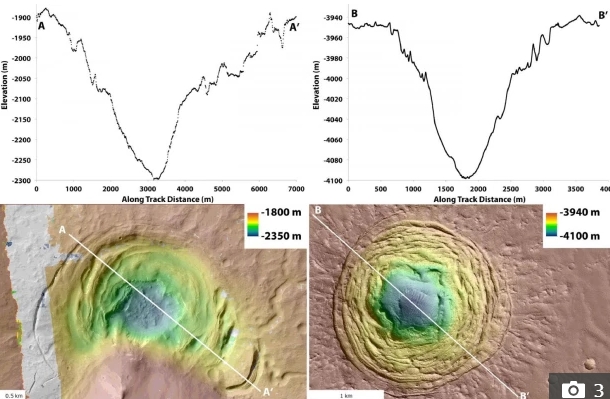Mysterious four mile wide ‘ice cauldron’ funnel on Mars ‘could hold ingredients for alien life’

A MYSTERIOUS funnel-shaped crater on the surface of Mars could hold the ingredients for alien life, scientists say.
A study shows the Hellas depression – 1,400ft deep and four miles wide – was probably formed by a volcano under a glacier and could have been a warm, wet, nutrient-rich environment ideal for microbes to grow
The depression is inside a huge crater perched on the rim of the Hellas basin region of Mars and surrounded by ancient glacial deposits.
Astronomers has been unsure whether it was originally created by a volcano or a meteor impact.
The new research suggests the Hellas depression and similar feature, the 2.5-mile wide Galaxias Fossae depression, should be the focus in the hunt for extraterrestrial life.
Joseph Levy, a research associate at the University of Texas Institute for Geophysics, said: “These landforms caught our eye because they’re weird looking.
“They’re concentrically fractured so they look like a bullseye. That can be a very diagnostic pattern you see in Earth materials.”
The Hellas depression first caught Levy’s attention in 2009, when he noticed crack-like features on pictures taken by the Mars Reconnaissance Orbiter.
He thought they looked similar to “ice cauldrons” on Earth, formations found in Iceland and Greenland when volcanos erupt under an ice sheet.
If that were the case, the heat from the volcano would melt the glacier and provide a source of liquid water for any lifeforms that may exist on the Red Planet.
Levy said: “We were drawn to this site because it looked like it could host some of the key ingredients for habitability—water, heat and nutrients.”
It was only this year that boffins were able to study the formations using pairs of high-definition stereoscopic images to model the detailed structure in 3D.
Analysis revealed both depressions shared an unusual funnel shape, with a broad perimeter that gradually narrowed with depth.
Levy said: “That surprised us and led to a lot of thinking about whether it meant there was melting concentrated in the centre that removed ice and allowed stuff to pour in from the sides.”
The researchers concluded the Hellas depression had many signs of volcanic origins like “ice cauldrons” on Earth.
It has a fracture pattern associated with concentrated removal of ice by melting.
The spread of debris around the Galaxias Fossae depression suggests that it was originally created by a meteor impact, but volcanic activity and ice melts have since made it bigger.
Evidence of the interaction of lava and ice would be an exciting find, the researchers say, because it could create an environment with liquid water and chemical nutrients, both ingredients required for life on Earth.
Their findings were published this month in Icarus, the International Journal of Solar System Studies.
Gro Pedersen, a volcanologist at the University of Iceland who was not involved with the study, said: “These features do really resemble ice cauldrons known from Earth, and just from that perspective they should be of great interest.”



 Creators of mankind
Creators of mankind Description of “Tall white aliens”
Description of “Tall white aliens” Where they came from?
Where they came from? About hostile civilizations
About hostile civilizations The war for the Earth
The war for the Earth “Tall white aliens” about eternal life
“Tall white aliens” about eternal life Video: “Nordic aliens”
Video: “Nordic aliens” Aliens
Aliens Alien encounters
Alien encounters The aliens base
The aliens base UFO
UFO Technology UFO
Technology UFO Underground civilization
Underground civilization Ancient alien artifacts
Ancient alien artifacts Military and UFO
Military and UFO Mysteries and hypotheses
Mysteries and hypotheses Scientific facts
Scientific facts


















